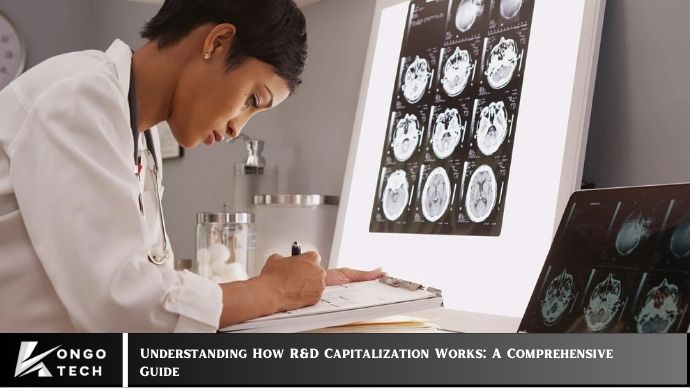Research and Development (R&D) is the backbone of innovation and technological progress for many companies, particularly in industries like technology, pharmaceuticals, and manufacturing. However, while R&D may drive innovation and long-term growth, accounting for these expenses can be tricky. One of the most important accounting practices is R&D capitalization—a method that allows businesses to treat some of their R&D expenses as capital assets rather than immediate expenses.
In this comprehensive guide, we’ll walk you through the ins and outs of R&D capitalization, from its definition and benefits to key principles and practical examples. Whether you are a startup, a growing tech company, or an established enterprise, understanding how R&D capitalization works can significantly impact your financial management, tax strategy, and growth trajectory.
What is R&D Capitalization?
R&D capitalization is an accounting practice that allows companies to treat certain research and development expenses as capital assets, rather than deducting them as immediate operating expenses. These costs are then amortized or depreciated over time, reflecting the long-term value they contribute to a company’s operations.
For example, a technology company that spends millions of dollars developing a new software product may capitalize some of these R&D expenses if they believe the software will generate long-term revenue. Instead of recognizing all of the development costs upfront, the company records them as an asset on the balance sheet and amortizes them over the expected useful life of the software.
Key Aspects of R&D Capitalization
- R&D Activities: R&D includes activities related to the creation of new products, software, or systems, as well as the improvement of existing ones.
- Capitalization vs. Expensing: Instead of immediately recognizing R&D costs as an expense (which affects current profits), capitalization spreads the costs out over several years.
- Amortization/Depreciation: Once R&D costs are capitalized, they are depreciated or amortized over time, based on the expected life of the product or technology developed.
Why Is R&D Capitalization Important?
R&D capitalizations can provide several significant benefits to a business, especially for companies heavily involved in innovation. Here’s why it’s important:
1. Improved Financial Performance Reporting
By capitalizing R&D costs, companies can spread out the expense over time. This results in smoother financial performance reporting, as expenses are not all recognized in one period. This practice can improve a company’s profitability in the short term, especially when there are significant ongoing R&D efforts.
2. Better Cash Flow Management
When R&D is capitalized, businesses do not have to deduct the full cost of research and development upfront, which can ease cash flow pressures. This is particularly important for startups or businesses investing heavily in product development.
3. Enhanced Tax Strategy
Certain R&D expenditures may qualify for tax credits or deductions. By capitalizing R&D costs, businesses may be able to take advantage of tax incentives while still reflecting the value of their investments on their balance sheets. Additionally, it can help manage taxable income more effectively by spreading the tax liability associated with these costs.
4. Attracting Investment
Investors often scrutinize a company’s financials to assess its profitability and potential for growth. By capitalizing R&D expenses, companies can show higher net income and asset values, which can make them more appealing to investors looking for financially sound and forward-thinking companies.
5. Compliance with Accounting Standards
R&D capitalization ensures compliance with accounting standards, including Generally Accepted Accounting Principles (GAAP) and International Financial Reporting Standards (IFRS). Following these standards is essential for businesses that want to ensure transparency and accountability in their financial reporting.
How Does R&D Capitalization Work?
The process of capitalizing R&D costs requires understanding the phases of R&D and applying the correct accounting treatment based on the stage of development.
1. Research Phase
During the research phase, a company is exploring new technologies or solutions, often with uncertain outcomes. Costs incurred during this stage are typically expensed immediately. These may include costs related to basic research, feasibility studies, or early-stage testing.
- Example: A pharmaceutical company conducting preliminary research into a new drug’s efficacy would expense these costs, as they have no guaranteed return on investment.
2. Development Phase
The development phase is when a company begins working on bringing a product or technology to market. At this point, the costs associated with development can often be capitalized, provided certain criteria are met. These include the technological feasibility of the product, the ability to generate future economic benefits, and the intention to commercialize the technology.
- Example: A software company creating a new app would capitalize costs once the product has reached a point of technological feasibility, meaning the development is likely to result in a successful product.
3. Amortization of Capitalized Costs
Once R&D costs are capitalized, they must be amortized (for intangible assets like software) or depreciated (for tangible assets like equipment). Amortization is the process of systematically allocating the capitalized cost over the asset’s useful life. The amortization period typically corresponds to the expected commercial life of the product or technology.
- Example: If a company capitalizes $2 million in R&D costs for a software product expected to have a 5-year useful life, they would amortize the costs by $400,000 per year over 5 years.
R&D Capitalization Under GAAP vs. IFRS
Both GAAP and IFRS provide guidelines on R&D capitalization, but the rules differ slightly between the two accounting frameworks.
GAAP (Generally Accepted Accounting Principles)
Under GAAP, R&D costs are generally expensed as incurred, unless the costs relate to the development of software for sale or for internal use. Software development costs, once technological feasibility is established, can be capitalized. Research costs, however, are generally not capitalized.
IFRS (International Financial Reporting Standards)
Under IFRS, R&D costs are treated differently. The IFRS allows companies to capitalize development costs, provided certain conditions are met, including the intention and ability to complete the product and use or sell it. This provides more flexibility for companies looking to capitalize on their development activities.
Key Differences Between GAAP and IFRS for R&D Capitalization
- GAAP is more conservative and generally requires expensing R&D costs during the research phase.
- IFRS allows for the capitalization of certain R&D development costs under more flexible guidelines.
Best Practices for R&D Capitalization
While R&D capitalization can offer significant benefits, it’s essential to follow best practices to ensure accuracy and compliance:
1. Clear Documentation
Maintain detailed records of all R&D activities, including the nature of the research and development, the stage of the project, and the costs incurred. This documentation is essential for justifying capitalization and for audits.
2. Separate R&D Projects
If your company undertakes multiple R&D projects, it’s crucial to keep the costs of each project separate for accurate tracking and capitalization. This ensures that only eligible costs are capitalized.
3. Regular Reviews
Review your capitalization policies regularly to ensure compliance with changing accounting standards and tax regulations. This is especially important as your business grows or when major regulatory changes occur.
4. Work with Auditors
Ensure that your R&D capitalization practices are reviewed by a qualified auditor. An auditor can help ensure compliance with accounting standards and advise you on best practices for R&D accounting.
5. Track Technological Feasibility
Only capitalize R&D costs when technological feasibility has been established. This is an important threshold that ensures the project is likely to result in a successful and commercially viable product.
Challenges of R&D Capitalization
While R&D capitalization offers many benefits, it does come with some challenges:
1. Complex Classification
Distinguishing between the research and development phases can sometimes be challenging, especially for complex projects. Misclassification of costs could lead to non-compliance with accounting standards.
2. Uncertain Outcomes
Since R&D activities often involve high levels of uncertainty, there is always a risk that capitalized costs may not result in a commercially viable product, leading to write-offs.
3. Regulatory Scrutiny
Given the complexity of R&D capitalization, tax authorities and auditors may scrutinize how companies apply the capitalization rules. It is essential to ensure compliance with the relevant standards and regulations.
Conclusion
R&D capitalization is a strategic financial practice that allows businesses to reflect the long-term value of their innovations while managing expenses more effectively. By capitalizing R&D costs, companies can improve profitability, enhance cash flow, reduce tax liabilities, and attract investors—all while fostering continuous innovation.
However, successful implementation requires a clear understanding of the criteria for capitalization, accurate record-keeping, and compliance with accounting standards. By adopting best practices and working closely with financial experts, companies can optimize their approach to R&D capitalization and unlock the full potential of their research and development investments.
FAQs
What are R&D capitalized costs?
R&D capitalized costs are research and development expenses that are recorded as assets on the balance sheet and amortized over time rather than being expensed immediately.
How do I determine if R&D costs should be capitalized?
R&D costs should be capitalized if the project has reached the development stage, has demonstrated technological feasibility, and is expected to generate future economic benefits.
Can software development costs be capitalized?
Yes, under both GAAP and IFRS, software development costs can be capitalized once technological feasibility has been established.
What is the difference between GAAP and IFRS for R&D capitalization?
GAAP is more conservative and typically requires R&D costs to be expensed, while IFRS allows for the capitalization of certain development costs under specific conditions.
What are the tax benefits of R&D capitalization?
By capitalizing R&D expenses, businesses may be able to take advantage of tax credits or deductions while improving their financial statements, thus optimizing their overall tax strategy.

